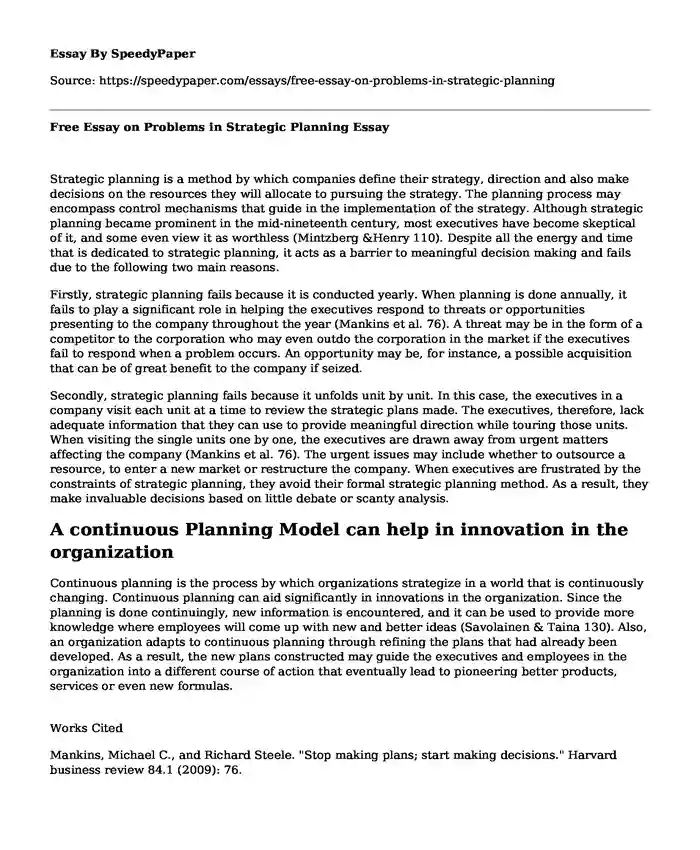
| Type of paper: | Case study |
| Categories: | Planning Strategic management Business strategy |
| Pages: | 2 |
| Wordcount: | 478 words |
Strategic planning is a method by which companies define their strategy, direction and also make decisions on the resources they will allocate to pursuing the strategy. The planning process may encompass control mechanisms that guide in the implementation of the strategy. Although strategic planning became prominent in the mid-nineteenth century, most executives have become skeptical of it, and some even view it as worthless (Mintzberg &Henry 110). Despite all the energy and time that is dedicated to strategic planning, it acts as a barrier to meaningful decision making and fails due to the following two main reasons.
Firstly, strategic planning fails because it is conducted yearly. When planning is done annually, it fails to play a significant role in helping the executives respond to threats or opportunities presenting to the company throughout the year (Mankins et al. 76). A threat may be in the form of a competitor to the corporation who may even outdo the corporation in the market if the executives fail to respond when a problem occurs. An opportunity may be, for instance, a possible acquisition that can be of great benefit to the company if seized.
Secondly, strategic planning fails because it unfolds unit by unit. In this case, the executives in a company visit each unit at a time to review the strategic plans made. The executives, therefore, lack adequate information that they can use to provide meaningful direction while touring those units. When visiting the single units one by one, the executives are drawn away from urgent matters affecting the company (Mankins et al. 76). The urgent issues may include whether to outsource a resource, to enter a new market or restructure the company. When executives are frustrated by the constraints of strategic planning, they avoid their formal strategic planning method. As a result, they make invaluable decisions based on little debate or scanty analysis.
A continuous Planning Model can help in innovation in the organization
Continuous planning is the process by which organizations strategize in a world that is continuously changing. Continuous planning can aid significantly in innovations in the organization. Since the planning is done continuingly, new information is encountered, and it can be used to provide more knowledge where employees will come up with new and better ideas (Savolainen & Taina 130). Also, an organization adapts to continuous planning through refining the plans that had already been developed. As a result, the new plans constructed may guide the executives and employees in the organization into a different course of action that eventually lead to pioneering better products, services or even new formulas.
Works Cited
Mankins, Michael C., and Richard Steele. "Stop making plans; start making decisions." Harvard business review 84.1 (2009): 76.
Mintzberg, Henry. "The fall and rise of strategic planning." Harvard business review 72.1 (2014): 107-114.
Savolainen, Taina I. "Cycles of continuous improvement: realizing competitive advantages through quality." International Journal of Operations & Production Management 19.11 (2011): 123-142.
Cite this page
Free Essay on Problems in Strategic Planning. (2022, Nov 30). Retrieved from https://speedypaper.com/essays/free-essay-on-problems-in-strategic-planning
Request Removal
If you are the original author of this essay and no longer wish to have it published on the SpeedyPaper website, please click below to request its removal:
- Free Essay on the Benefits of Going to College
- Marketing Essay Sample on Customer Lifetime Value
- Annotated Bibliography Example on Sociological Issues
- HR Essay Sample on Project Manager Recruitment
- Essay Example: Tennis Is My Favourite Sport
- Critical Essay on "Becoming": A Memoir by Mitchell Obama
- Essay on Navigating Global Sourcing: Risks, Costs, and Strategies for Effective Supplier Management
Popular categories




